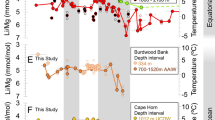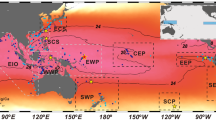Abstract
The western warm pools of the Atlantic and Pacific oceans are a critical source of heat and moisture for the tropical climate system. Over the past five million years, global mean temperatures have cooled by 3–4 °C. Yet, present reconstructions of sea surface temperatures indicate that temperature in the warm pools has remained stable during this time. This stability has been used to suggest that tropical sea surface temperatures are controlled by a thermostat-like mechanism that maintained consistent temperatures. Here we reconstruct sea surface temperatures in the South China Sea, Caribbean Sea and western equatorial Pacific Ocean for the past five million years, using a combination of the Mg/Ca-, TEX86H- and  -surface-temperature proxies. Our data indicate that during the period of Pliocene warmth from about 5 to 2.6 million years ago, the western Pacific and western Atlantic warm pools were about 2 °C warmer than today. We suggest that the apparent lack of warmth seen in the previous reconstructions was an artefact of low seawater Mg/Ca ratios in the Pliocene oceans. Taking this bias into account, our data indicate that tropical sea surface temperatures did change in conjunction with global mean temperatures. We therefore conclude that the temperature of the warm pools of the equatorial oceans during the Pliocene was not limited by a thermostat-like mechanism.
-surface-temperature proxies. Our data indicate that during the period of Pliocene warmth from about 5 to 2.6 million years ago, the western Pacific and western Atlantic warm pools were about 2 °C warmer than today. We suggest that the apparent lack of warmth seen in the previous reconstructions was an artefact of low seawater Mg/Ca ratios in the Pliocene oceans. Taking this bias into account, our data indicate that tropical sea surface temperatures did change in conjunction with global mean temperatures. We therefore conclude that the temperature of the warm pools of the equatorial oceans during the Pliocene was not limited by a thermostat-like mechanism.
This is a preview of subscription content, access via your institution
Access options
Subscribe to this journal
Receive 12 print issues and online access
$259.00 per year
only $21.58 per issue
Buy this article
- Purchase on Springer Link
- Instant access to full article PDF
Prices may be subject to local taxes which are calculated during checkout



Similar content being viewed by others
References
Pierrehumbert, R. Climate change and the tropical Pacific: The sleeping dragon wakes. Proc. Natl Acad. Sci. USA 97, 1355–1358 (2000).
Wang, C. & Enfield, D. B. The tropical Western Hemisphere warm pool. Geophys. Res. Lett. 28, 1635–1638 (2001).
Herbert, T. D., Peterson, L. C., Lawrence, K. T. & Liu, Z. Tropical ocean temperatures over the past 3.5 million years. Science 328, 1530–1534 (2010).
Brierley, C. M. et al. Greatly expanded tropical warm pool and weakened Hadley circulation in the early Pliocene. Science 323, 1714–1718 (2009).
Wara, M. W., Ravelo, A. C. & Delaney, M. L. Permanent El Niño-like conditions during the Pliocene warm period. Science 309, 758–761 (2005).
Fedorov, A. et al. Patterns and mechanisms of early Pliocene warmth. Nature 496, 43–49 (2013).
Ramanathan, V. & Collins, W. Thermodynamic regulation of ocean warming by cirrus clouds deduced from observations of the 1987 El Nino. Nature 351, 27–32 (1991).
Newell, R. E. Climate and the Ocean: Measurements of changes in sea-surface temperature should permit us to forecast certain climatic changes several months ahead. Am. Sci. 67, 405–416 (1979).
Williams, I. N., Pierrehumbert, R. T. & Huber, M. Global warming, convective threshold and false thermostats. Geophys. Res. Lett. 36, L21805 (2009).
Van Hooidonk, R. & Huber, M. Equivocal evidence for a thermostat and unusually low levels of coral bleaching in the Western Pacific Warm Pool. Geophys. Res. Lett. 36, L06705 (2009).
Medina-Elizalde, M. & Lea, D. W. Late Pliocene equatorial Pacific. Paleoceanography 25, PA2208 (2010).
Lea, D. W., Pak, D. K. & Spero, H. J. Climate impact of late quaternary equatorial Pacific Sea surface temperature variations. Science 289, 1719–1724 (2000).
Rohling, E., Medina-Elizalde, M., Shepherd, J., Siddall, M. & Stanford, J. Sea surface and high-latitude temperature sensitivity to radiative forcing of climate over several glacial cycles. J. Clim. 25, 1635–1656 (2012).
Dowsett, H. J. et al. Assessing confidence in Pliocene sea surface temperatures to evaluate predictive models. Nature Clim. Change 2, 365–371 (2012).
Müller, P. J., Kirst, G., Ruhland, G., Von Storch, I. & Rosell-Melé, A. Calibration of the alkenone paleotemperature index UK’37 based on core-tops from the eastern South Atlantic and the global ocean (60 N-60 S). Geochim. Cosmochim. Acta 62, 1757–1772 (1998).
Medina-Elizalde, M., Lea, D. W. & Fantle, M. S. Implications of seawater Mg/Ca variability for Plio-Pleistocene tropical climate reconstruction. Earth Planet. Sci. Lett. 269, 585–595 (2008).
Coggon, R. M., Teagle, D. A. H., Smith-Duque, C. E., Alt, J. C. & Cooper, M. J. Reconstructing past seawater Mg/Ca and Sr/Ca from mid-ocean ridge flank calcium carbonate veins. Science 327, 1114–1117 (2010).
Lowenstein, T. K., Timofeeff, M. N., Brennan, S. T., Hardie, L. A. & Demicco, R. V. Oscillations in Phanerozoic seawater chemistry: Evidence from fluid inclusions. Science 294, 1086–1088 (2001).
Fantle, M. S. & DePaolo, D. J. Sr isotopes and pore fluid chemistry in carbonate sediment of the Ontong Java Plateau: Calcite recrystallization rates and evidence for a rapid rise in seawater Mg over the last 10 million years. Geochim. Cosmochim. Acta 70, 3883–3904 (2006).
Stanley, S. M. & Hardie, L. A. Secular oscillations in the carbonate mineralogy of reef-building and sediment-producing organisms driven by tectonically forced shifts in seawater chemistry. Palaeogeogr. Palaeoclimatol. Palaeoecol. 144, 3–19 (1998).
Rausch, S., Böhm, F., Bach, W., Klügel, A. & Eisenhauer, A. Calcium carbonate veins in ocean crust record a threefold increase of seawater Mg/Ca in the past 30 million years. Earth Planet. Sci. Lett. 362, 215–224 (2013).
Dekens, P. S., Ravelo, A. C., McCarthy, M. D. & Edwards, C. A. A 5 million year comparison of Mg/Ca and alkenone paleothermometers. Geochem. Geophys. Geosyst. 9, Q10001 (2008).
Li, L. et al. A 4-Ma record of thermal evolution in the tropical western Pacific and its implications on climate change. Earth Planet. Sci. Lett. 309, 10–20 (2011).
Groeneveld, J. Effect of the Pliocene Closure of the Panamanian Gateway on Caribbean and East Pacific Sea Surface Temperatures and Salinities by Applying Combined Mg/Ca and δ18O Measurements (5.6–2.2 Ma) PhD thesis, Univ. Kiel (2005)
Seki, O. et al. Alkenone and boron-based Pliocene pCO2 records. Earth Planet. Sci. Lett. 292, 201–211 (2010).
Badger, M. P., Schmidt, D. N., Mackensen, A. & Pancost, R. D. High-resolution alkenone palaeobarometry indicates relatively stable pCO2 during the Pliocene (3.3–2.8 Ma). Phil. Trans. R. Soc. A 371, 20130094 (2013).
Seki, O. et al. Paleoceanographic changes in the Eastern Equatorial Pacific over the last 10 Myr. Paleoceanography 27, PA3224 (2012).
Hollis, C. J. et al. Early Paleogene temperature history of the southwest Pacific Ocean: Reconciling proxies and models. Earth Planet. Sci. Lett. 349, 53–66 (2012).
Wei, Y. et al. Spatial variations in archaeal lipids of surface water and core-top sediments in the South China Sea and their implications for paleoclimate studies. Appl. Environ. Microbiol. 77, 7479–7489 (2011).
Locarnini, R. A. et al. in NOAA Atlas NESDIS 68 Vol. 1 (ed Levitus, S.) (US Government Printing Office, 2010).
Tian, J. et al. Late Pliocene monsoon linkage in the tropical South China Sea. Earth Planet. Sci. Lett. 252, 72–81 (2006).
Schmidt, M. W., Vautravers, M. J. & Spero, H. J. Western Caribbean sea surface temperatures during the late Quaternary. Geochem. Geophys. Geosyst. 7, Q02P10 (2006).
Wunsch, C. A perpetually running ENSO in the Pliocene? J. Clim. 22, 3506–3510 (2009).
Fraile, I., Mulitza, S. & Schulz, M. Modeling planktonic foraminiferal seasonality: Implications for sea-surface temperature reconstructions. Mar. Micropaleontol. 72, 1–9 (2009).
Hemleben, C., Spindler, M. & Erson, O. Modern Planktonic Foraminifera (Springer, 1989).
Evans, D. & Müller, W. Deep time foraminifera Mg/Ca paleothermometry: Nonlinear correction for secular change in seawater Mg/Ca. Paleoceanography 27, PA4205 (2012).
Horita, J., Zimmermann, H. & Holland, H. D. Chemical evolution of seawater during the Phanerozoic: Implications from the record of marine evaporites. Geochim. Cosmochim. Acta 66, 3733–3756 (2002).
Higgins, J. & Schrag, D. Records of Neogene seawater chemistry and diagenesis in deep-sea carbonate sediments and pore fluids. Earth Planet. Sci. Lett. 357, 386–396 (2012).
Wilkinson, B. H. & Algeo, T. J. Sedimentary carbonate record of calcium-magnesium cycling. Am. J. Sci. 289, 1158–1194 (1989).
Köhler, P. et al. What caused Earth’s temperature variations during the last 800,000 years? Data-based evidence on radiative forcing and constraints on climate sensitivity. Quat. Sci. Rev. 29, 129–145 (2010).
Rohling, E. J. et al. Sea-level and deep-sea-temperature variability over the past 5.3 million years. Nature 508, 477–482 (2014).
Dowsett, H. J. et al. Sea surface temperature of the mid-Piacenzian ocean: A data-model comparison. Sci. Rep. 3 (2013).
Schouten, S., Hopmans, E. C., Schefuß, E. & Sinninghe Damsté, J. S. Distributional variations in marine crenarchaeotal membrane lipids: A new tool for reconstructing ancient sea water temperatures? Earth Planet. Sci. Lett. 204, 265–274 (2002).
Kim, J. H. et al. New indices and calibrations derived from the distribution of crenarchaeal isoprenoid tetraether lipids: Implications for past sea surface temperature reconstructions. Geochim. Cosmochim. Acta 74, 4639–4654 (2010).
Barker, S., Greaves, M. & Elderfield, H. A study of cleaning procedures used for foraminiferal Mg/Ca paleothermometry. Geochem. Geophys. Geosyst. 4, 8407 (2003).
Yu, J., Elderfield, H., Greaves, M. & Day, J. Preferential dissolution of benthic foraminiferal calcite during laboratory reductive cleaning. Geochem. Geophys. Geosyst. 8, Q06016 (2007).
Foster, G. L. Seawater pH, pCO2 and [CO32−] variations in the Caribbean Sea over the last 130 kyr: A boron isotope and B/Ca study of planktic foraminifera. Earth Planet. Sci. Lett. 271, 254–266 (2008).
Schlitzer, R. Interactive analysis and visualization of geoscience data with Ocean Data View. Comput. Geosci. 28, 1211–1218 (2002).
Pagani, M., Liu, Z., LaRiviere, J. & Ravelo, A. C. High earth-system climate sensitivity determined from Pliocene carbon dioxide concentrations. Nature Geosci. 3, 27–30 (2009).
Lisiecki, L. E. & Raymo, M. E. A Pliocene–Pleistocene stack of 57 globally distributed benthic δ18O records. Paleoceanography 20, PA1003 (2005).
Acknowledgements
This work was supported by a NERC studentship awarded to C.L.O’B. and a NERC standard grant NE/H006273/1 awarded to R.D.P. (Principal Investigator) and G.L.F. (Co-Investigator). R.D.P. also acknowledges the Royal Society Wolfson Research Merit Award. M.A.M-B. gratefully acknowledges the support of the European Community through a Marie Curie Intra-European Fellowship for Career Development. Samples were provided by the Integrated Ocean Drilling Program. We would like to thank K. Edgar for helpful discussions on diagenesis of foraminifera.
Author information
Authors and Affiliations
Contributions
C.L.O’B. collected all of the data (except where otherwise noted), interpreted results, and prepared the manuscript and figures. G.L.F. and R.D.P. supervised the project, and aided in interpretation, figure making and editing the manuscript. M.A.M-B. generated the G. ruber Mg/Ca data for Site 999. R.A. and G.L.F. generated the G. sacculifer Mg/Ca data for Site 999. J.W.B.R. aided in the collection of G. sacculifer Mg/Ca data for Site 1143, figure making and editing the manuscript.
Corresponding author
Ethics declarations
Competing interests
The authors declare no competing financial interests.
Supplementary information
Rights and permissions
About this article
Cite this article
O’Brien, C., Foster, G., Martínez-Botí, M. et al. High sea surface temperatures in tropical warm pools during the Pliocene. Nature Geosci 7, 606–611 (2014). https://doi.org/10.1038/ngeo2194
Received:
Accepted:
Published:
Issue Date:
DOI: https://doi.org/10.1038/ngeo2194
This article is cited by
-
Persistent high latitude amplification of the Pacific Ocean over the past 10 million years
Nature Communications (2022)
-
Enhanced ocean oxygenation during Cenozoic warm periods
Nature (2022)
-
Sustained mid-Pliocene warmth led to deep water formation in the North Pacific
Nature Geoscience (2022)
-
Mid-Pliocene El Niño/Southern Oscillation suppressed by Pacific intertropical convergence zone shift
Nature Geoscience (2022)
-
The PhanSST global database of Phanerozoic sea surface temperature proxy data
Scientific Data (2022)



